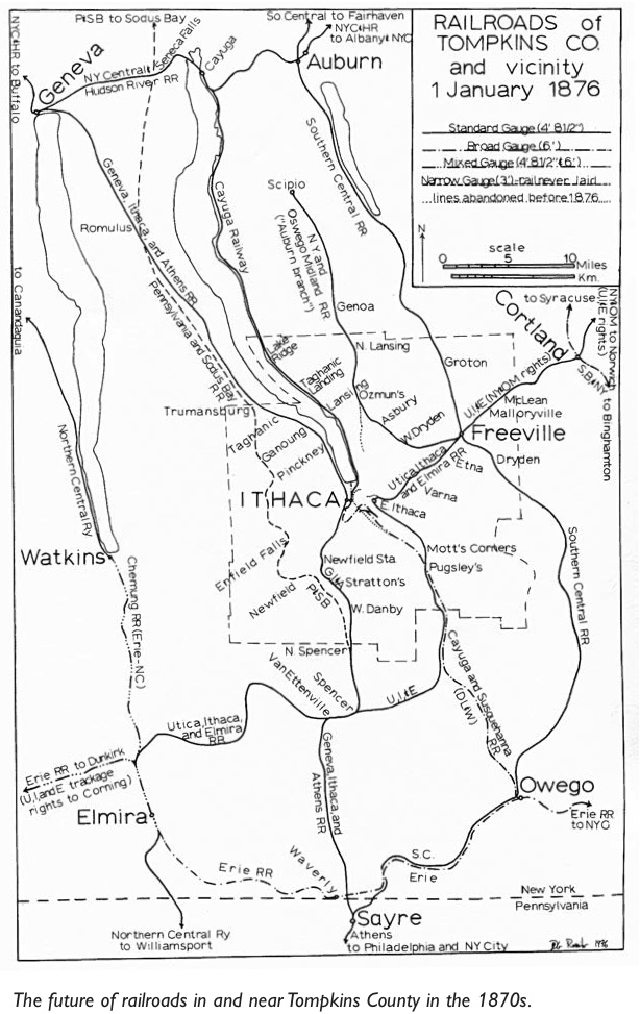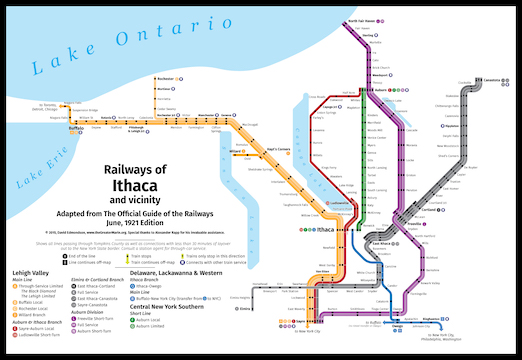
Ithaca had its own 19th century railway rush
The Ithaca Journal, Centennial edition, Friday, 08-April-1988By D G Rossiter

In 1888, the railroad was the primary means of transportation for the new City of Ithaca. The principal road was the Geneva, Ithaca, and Sayre Railroad, connecting at Geneva with the New York Central to the west, and at Sayre with the Lehigh Valley to the south. Also part of this railroad was the former Cayuga Lake Railroad, which ran up the east side of the lake to a junction with the New York Central at Cayuga.
The Delaware, Lackwanna, and Western Railroad (DL&W) served Ithaca with a branch line from its main line at Owego, where connections could be made to New York or Buffalo. And the Elmira, Cortland, and Northern ran from the East Ithaca station, high on the hill, northeast to Freeville, Cortland, and the New York Central main line at Canastota, and southwest to Horseheads and the Erie railroad.
Ithaca was important to these railroads as a manufacturing and retailing center, and as a minor trans-shipment point to the Erie Canal navigation. But the early promoters of Ithaca's railroads had hoped for much more.
Ithaca got into the railroad business very early, during the late 1820s when the canal was still king of transportation. Ithaca was well situated on Cayuga Lake for canal traffic northward, but the hills high to the south made a canal to the Susquehanna impractical. Consequently, a committee of citizens of Tioga and Tompkins counties obtained a charter in 1828 from the state Legislature to build a railroad from Owego, on the Susquehanna, to Ithaca, on the Erie Canal system. It was hoped that this route would become a major bridge between these two river systems, and bring wealth to the two trans-shipment points.
The Ithaca and Owego Railroad opened in 1834, the fourth in the state. Technologically, it resembled a canal more than it did a modern railway. Horses pulled wagons on wooden rails that had thin pieces of strap iron nailed on top. Cars were raised and lowered from the Ithaca flats to the top of South Hill on two inclined planes, by horses walking in an endless circle in the power houses.
In 1840 a primitive steam locomotive was placed in service, but the trip to Owego still took more than three hours. The inclined planes were expensive to maintain and dangerous. The road failed in 1842, and was rebuilt in the late '40s to more modern standards. By 1851 the planes had been replaced with switchbacks and a long loop down into the valley, and a connection had been made with the Liggett's Gap Railroad (later the DL&W) at Owego.
Finally Ithaca had a real railroad, and until the Civil War Ithaca prospered as a trans-shipment point for Lackawanna anthracite. After the war, this business was eliminated by the construction of through railroads from the Pennsylvania coal fields to the Upstate New York and Canadian manufacturing centers.
During the 1850s and '60s, railroad fever was at a high pitch in the United States. Forward-looking citizens in all communities realized that good railroads were vital for their growth. In Ithaca, many schemes were made and charters granted during this period. Extensive grading took place in 1853 on the "Murdock" line, which was to form a northern outlet for the DL&W. It was to run from a junction with the Owego branch near Caroline Depot, through Brooktondale and East Ithaca to South Lansing and eventually to Auburn and Fair Haven on Lake Ontario. This route was vigorously opposed by the village of Ithaca, which wanted the line to run through the flats rather than up on East Hill. In 1854, work stopped due to lack of funds, and never resumed.
No road was completed until after the Civil War, when Ezra Cornell used an estimated $2 million of his fortune, as well as his business sense and political connections, to promote two railraods: the Ithaca and Athens to the south, and the Ithaca and Cortland to the east. These opened in 1871, and by Cornell's death in 1874 had been extended north to Geneva and west to Horseheads.
Cornell had special hopes for the Horseheads road, seeing it as a major route for coal from the Blossburg fields [in Pennsylvania] to New England. However, the Erie and New York Central got most of this traffic; the line was never profitable and was abandoned in 1935.
[The Cayuga Lake Railroad was opened from Ithaca to Cayuga Junction [with the Auburn Road of the New York Central] in 1872, along the E shore of the lake, and was later extended east to Auburn.]
The 1890s saw the Lehigh Valley system absorb every line in the county except the Owego line, which was owned by the DL&W. But the Lehigh bypassed Ithaca when it built its main line to Buffalo in 1890 [via eastern Schuyler County], because of the steep grades in both directions on the Sayre-Ithaca-Geneva route. Ithaca was relegated to permanent branch-line status.
[From 1890 to WWII] Ithaca had good, albeit slow, passenger service from the main [Lehigh Valley] station on Buffalo Street to New York and Philadelphia via Wilkes-Barre and Bethlehem, to Buffalo and points west, and to Albany and New England via the Cayuga Lake line and a New York Central connection at Auburn. Service to the northeast also ran out of the East Ithaca depot, and the DL&W ran trains to Owego, connecting with its main line to Buffalo, Scranton, and New York.
Ithaca got caught up in the inter-urban railway boom of the early 20th century, with the completion of the Ithaca-Auburn Short Line in 1908. The section of this line from Ithaca to South Lansing and the Rogue's Harbor Inn was electrified and operated by streetcars. The line was a mistake from the beginning, running as it did through a very sparsely populated area, and the rapidly-improving highway system, especially the parallel state route 34, caused the line's abandonment in 1923.
The Lehigh Valley Railroad and Cornell University always had a special relationship, based in part on Ezra Cornell's legacy, and in part on the importance of Ithaca as a passenger station due to heavy student traffic. When the Lehigh replaced steam locomotives with diesel ones in the 1950s, they were painted a color officially described as "Cornell Red".
The general decline of railroads in the United States was paralleled in Ithaca. Freight travelled on trucks, and people drove their cars [or took the bus on an excellent highway system]. The Lehigh Valley's premier passenger train, the Black Diamond, made its final trip on May 11, 1959. By the 1960s, freight traffic was almost exclusively rock salt from the Cayuga Rock Salt company (now Cargill), and coal for the Milliken station of New York State Electric & Gas at Lake Ridge (built in 1954) [, both on the Cayuga Lake line].
On April 1, 1976, the Consolidated Rail Corp. (Conrail) was formed to pick up the pieces of six failed eastern roads, including the Lehigh Valley. Conrail's mandate from Congress was to prune the railroad map of the East drastically, retaining only lines that could pay their own way. This meant either lines with heavy through traffic, or lines with a large amount of bulk freight that could not easily be handled by trucks. Hence the Sayre-Ithaca-Myers-Lake Ridge line was included in Conrail. In the summer of 1984 this line was rebuilt to mainline standards.
Today [1988], Ithaca sees service about five days a week. Trains run from Gang Mills yard (west of Corning), over the ex-Erie to Waverly, then by a connecting spur to Sayre, and then up the Ithaca & Athens line to Ithaca, and the Cayuga Lake line to Lake Ridge. Cargill and NYSEG account for almost all the carloads. A few local industries receive an occasional load of bulk materials, and Cornell University receives its heating coal at the Clinton Street yards.
For more information on this subject, as well as detailed maps, see "A History of Railroads in Tompkins County", by Hardy Campbell Lee (1947), revised and enlarged by Winton Rossiter, published by the DeWitt Historical Society (1977) [and in a revised edition by the re-named History Center in Tompkins County (2008) and available in local bookstores; the PDF is available here (3 Mb).]
Note: This version has been slightly modified from the published version: (1) spelling, punctuation, and paragraph division have been adjusted to my current taste, (2) some information has been expanded (always in [square brackets]).

The above-mentioned book includes the following map drawn by yours truly, showing the situation in the late 1870's, about a decade before Ithaca became a city.

Age of Rail: Ithaca, NY, in 1921, a NYC-subway style map of service around Ithaca in 1921, by David Edmonson. "Painstakingly recreated from the Lehigh Valley, Delaware, Lackawanna & Western, and Central New York Southern timetables, see the train system that Cornell and Ithaca College had for generations and that students still long for today. Add it to your dorm room wall next to that New York City Subway map, or show off your Ithaca pride with a trip through history." For purchase as a poster, but a good PDF can be downloaded. Here is a thumbnail with link to the full-size map:

Here is a map showing the locations mentioned in the tour guide.
Here are some old newspaper columns that were forwarded to me by Richard Palmer, in chronological order of publication. I am pleased to make them easily available here.
This railroad was to run from N Spencer to Lake Ontario via Newfield, Enfield, Trumansburg, and Seneca Falls. It was never completed, a casualty of the panic of 1873. The grades were constructed for narrow gauge.
This was Ithaca's first outlet to the north. It had severe problems with flooding and track erosion from the lake until the lake level was better controlled.